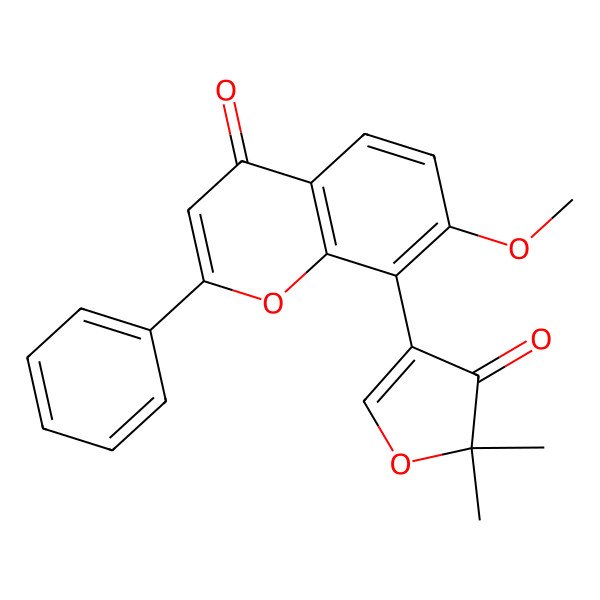8-(5,5-Dimethyl-4-oxofuran-3-yl)-7-methoxy-2-phenylchromen-4-one
| Internal ID | 66efbe01-8662-4155-ad02-a759551733fc |
| Taxonomy | Phenylpropanoids and polyketides > Flavonoids > Flavones > 8-prenylated flavones |
| IUPAC Name | 8-(5,5-dimethyl-4-oxofuran-3-yl)-7-methoxy-2-phenylchromen-4-one |
| SMILES (Canonical) | CC1(C(=O)C(=CO1)C2=C(C=CC3=C2OC(=CC3=O)C4=CC=CC=C4)OC)C |
| SMILES (Isomeric) | CC1(C(=O)C(=CO1)C2=C(C=CC3=C2OC(=CC3=O)C4=CC=CC=C4)OC)C |
| InChI | InChI=1S/C22H18O5/c1-22(2)21(24)15(12-26-22)19-17(25-3)10-9-14-16(23)11-18(27-20(14)19)13-7-5-4-6-8-13/h4-12H,1-3H3 |
| InChI Key | IJRSTLGZIYDKHD-UHFFFAOYSA-N |
| Popularity | 0 references in papers |
| Molecular Formula | C22H18O5 |
| Molecular Weight | 362.40 g/mol |
| Exact Mass | 362.11542367 g/mol |
| Topological Polar Surface Area (TPSA) | 61.80 Ų |
| XlogP | 3.50 |
| There are no found synonyms. |

| Target | Value | Probability (raw) | Probability (%) |
|---|---|---|---|
| No predicted properties yet! | |||
Proven Targets:
| CHEMBL ID | UniProt ID | Name | Min activity | Assay type | Source |
|---|---|---|---|---|---|
| No proven targets yet! | |||||
Predicted Targets (via Super-PRED):
| CHEMBL ID | UniProt ID | Name | Probability | Model accuracy |
|---|---|---|---|---|
| CHEMBL5619 | P27695 | DNA-(apurinic or apyrimidinic site) lyase | 98.55% | 91.11% |
| CHEMBL3108638 | O15164 | Transcription intermediary factor 1-alpha | 96.34% | 95.56% |
| CHEMBL1293249 | Q13887 | Kruppel-like factor 5 | 96.18% | 86.33% |
| CHEMBL2581 | P07339 | Cathepsin D | 95.33% | 98.95% |
| CHEMBL4306 | P22460 | Voltage-gated potassium channel subunit Kv1.5 | 92.62% | 94.03% |
| CHEMBL2635 | P51452 | Dual specificity protein phosphatase 3 | 90.00% | 94.00% |
| CHEMBL1255126 | O15151 | Protein Mdm4 | 89.93% | 90.20% |
| CHEMBL3091268 | Q92753 | Nuclear receptor ROR-beta | 88.80% | 95.50% |
| CHEMBL1806 | P11388 | DNA topoisomerase II alpha | 87.98% | 89.00% |
| CHEMBL3192 | Q9BY41 | Histone deacetylase 8 | 85.80% | 93.99% |
| CHEMBL4478 | Q00975 | Voltage-gated N-type calcium channel alpha-1B subunit | 85.45% | 97.14% |
| CHEMBL1907 | P15144 | Aminopeptidase N | 83.72% | 93.31% |
| CHEMBL4203 | Q9HAZ1 | Dual specificity protein kinase CLK4 | 81.80% | 94.45% |
| CHEMBL3038477 | P67870 | Casein kinase II alpha/beta | 81.73% | 99.23% |
| CHEMBL4261 | Q16665 | Hypoxia-inducible factor 1 alpha | 81.58% | 85.14% |
| CHEMBL1075094 | Q16236 | Nuclear factor erythroid 2-related factor 2 | 81.01% | 96.00% |
Below are displayed all the plants proven (via scientific papers) to contain this
compound!
To see more specific details click the taxa you are interested in.
To see more specific details click the taxa you are interested in.
| Tephrosia purpurea |
| PubChem | 21721923 |
| LOTUS | LTS0031403 |
| wikiData | Q104397307 |